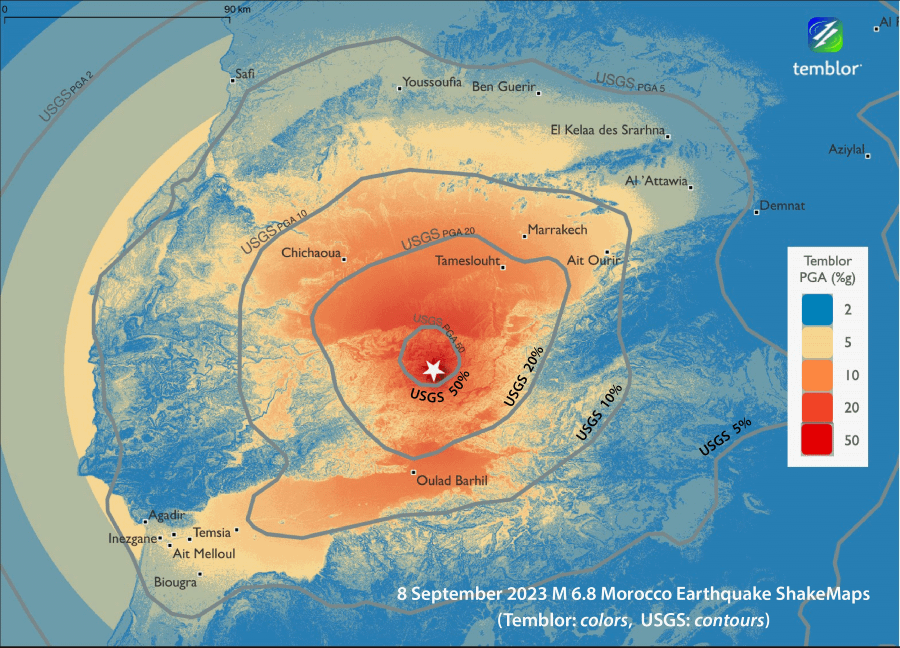Technical details:
The earthquake struck at 22:11 UTC on Friday 8 September 2023 (23:11 local time, WEST), within the Atlas Mountains in western Morocco ~70km south-west of Marrakesh and ~135km north-east of Agadir.
The epicentre was located at 31.064°N 8.391°W, at a depth of 26km (according to USGS, Morocco's National Institute of Geophysics suggests depth as shallow as 8km). The event was thought to be a low-angle south-westerly dipping oblique thrust (reverse) failure of the North Atlas Fault, within the High Atlas Range of the African/Nubian plate ~550km south of its boundary with the Eurasian plate. Due to the complex nature of this fault system and relative lack of similarly sized earthquakes in this region, there is some uncertainty in the focal mechanism. Moment magnitude was 6.8Mw, with the highest Modified Mercalli Intensity (MMI) recorded to be VIII (severe) to the immediate north of the epicentre (Fig. 1). Intensities as high as IV (moderate) were reported up to 300km from the epicentre, throughout Morocco as well as Algeria, Spain and Portugal.
26km epicentral depth according to USGS
6.8Mw moment magnitude
There is continued risk from aftershocks in the days and weeks following the event, and significant risk of landslides due to the mountainous terrain in the area. Adassil, a town located ~10km north-west of the epicentre with a population of over 7,000, is reported to be completely buried by rubble due to a large landslide following the earthquake.

Source: Temblor Inc.
Human and infrastructure loss details:
At the time of writing, government reports indicate at least 2,681 people are known to have died and a further 2,476 injured, many of them critically. Thousands more are thought to be left homeless, with more than 18,000 families affected by the event in Al-Haouz province, site of the epicentre, and at least 300,000 people in Marrakesh and its surrounding regions according to the World Health Organisation (WHO).
Significant damage to buildings in Marrakesh, with villages close to the epicentre almost completely destroyed. Tafeghaghte, ~60km from Marrakesh in Al-Haouz province, was reported to have few buildings still standing, and a village near Asni ~40km south of Marrakesh reported all buildings had either collapsed or suffered significant structural damage.
Many of these buildings are thought to be constructed from mud bricks, and not resistant to earthquake shaking. The timing of the earthquake meant many people were sleeping inside these buildings, contributing to the high rate of injuries and deaths.
>18k families affected in Al-Haouz province
>300k people in Marrakesh and surrounding regions affected according to the WHO
USGS’s ‘Prompt Assessment of Global Earthquakes for Response’ (PAGER) system estimates high casualties (1,000-10,000) and extensive damage are probable, and the disaster is likely widespread. Estimated economic losses are in the region of $1-10bn USD, up to 8% of Morocco’s GDP (Fig. 2). A smaller Mw5.8 event that occurred ~140km to the south-west of this event in 1960 was reported to have killed between 12,000-15,000 people, mostly due to the complete collapse of buildings constructed from compacted earth.
12-15k fatalities from nearby 1960 Mw5.8 event
8% of Morocco's GDP estimated economic loss (PAGER)

Source: USGS
As means of insurance funds to assist with relief, the “Solidarity Fund against Catastrophic Events” (FSEC) is a public financial entity established for the purpose of mitigating the economic and social impacts of catastrophic events in Morocco. This project was headed by multiple teams across WTW, with contributions from Willis Re (now Gallagher Re), the Disaster Risk Finance and Parametrics team within the Climate and Resilience Hub, Alternative Risk Transfer and the WTW Research Network, as well as event shaking footprints modelled through the Global Earthquake Model Foundation's (GEM) OpenQuake platform. The product comprises a parametric earthquake risk transfer solution based on reported earthquake shaking intensity, and in the wake of this earthquake it is estimated to potentially pay out up to $275m USD to support recovery amongst vulnerable communities.